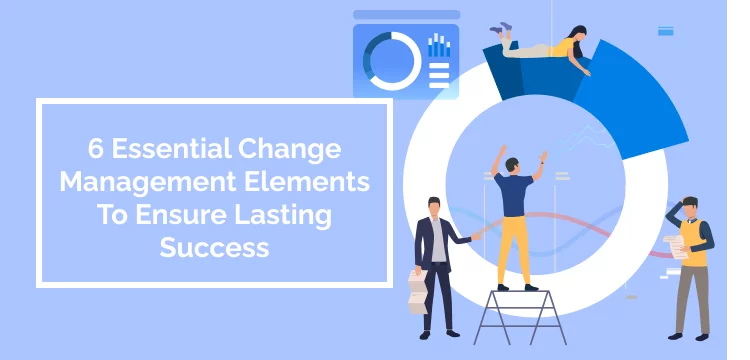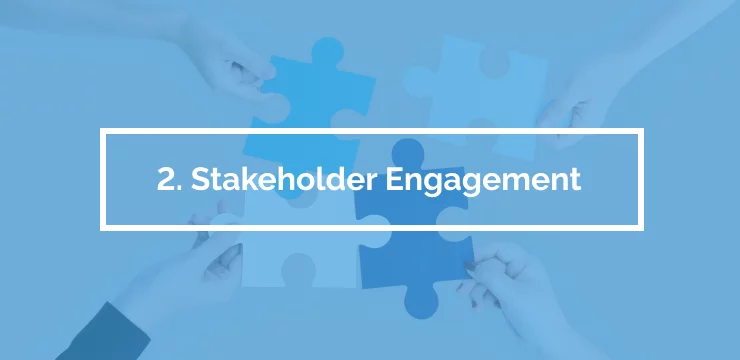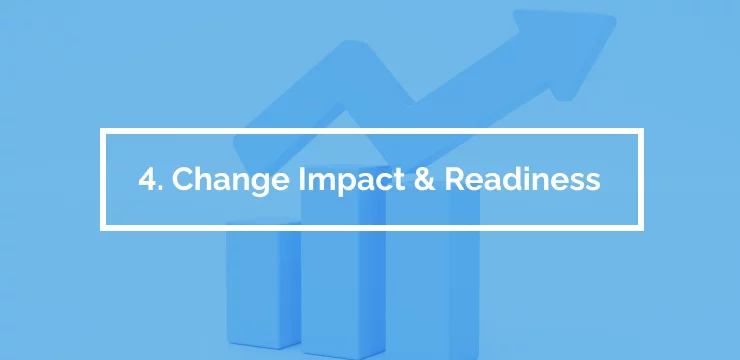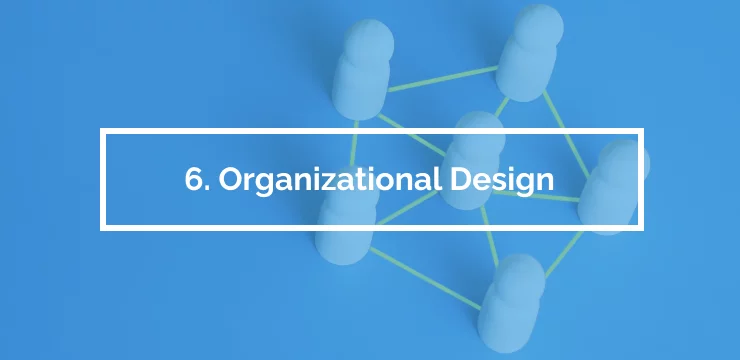
The essential elements of change management include leadership alignment, stakeholder engagement, communication, training, change impact, readiness assessments, and organizational design. Successful change management programs encourage and facilitate the adoption of new ideas, processes, or management models. But only a lackluster 34% of change initiatives achieve clear success.
Change management keeps project stakeholders happy and motivated as the organization endures transitions of change. It’s about getting the entire organization on the same page through clear communication and training.
We’ve identified these elements of change management that will achieve lasting business success.
1. Leadership Alignment

Glenn Llopis, the author of Leadership in the Age of Personalization, mentions that most organizations fail to achieve lasting success with change management because of internal politics. Even though these organizations need change urgently, internal politics can’t allow them to reach a consensus on various leadership levels. They lose momentum in the change process, and competitors overtake them.
Misspent time, wasted money, dissatisfied customers and disengaged employees are some of the results of poor leadership alignment during a transition.
But you want all the leaders on the same page regarding the changes and what they’ll mean for the organization. These leaders will lead the rest of the organization by example and present a united front.
So consider these tips for aligning leadership in change management:
- Define your mission in the change process – which aligns with the organization’s overall strategy and goals.
- Create a clear picture of success (vision), both financially and operationally – the leaders should have a clear end goal in mind.
- Define the core resources and relationships to accomplish business goals and achieve sustainable success. The leaders should know their roles in the change process.
- Define success criteria and monitoring system – the leaders should know how to track the success/failure of the change processes.
2. Stakeholder Engagement

Stakeholder engagement involves all the activities for engaging, supporting, and updating stakeholders in the organizational change management process. Each stakeholder will have different activities. For example, an influencer against the change will need resistance management activities.
Because you don’t want an opinion overload when creating the change plan, identify the stakeholders that impact the project’s success. For example, if you’re developing a new customer survey that your sales department will use in their day-to-day communication with customers, engage the sales team as their key stakeholders.
Tips for engaging stakeholders:
- Communicate with the stakeholders regularly – have detailed communication plans from the onset for check-ins, updates, and feedback.
- Ensure all stakeholders understand the change’s benefits from their perspective and the details of the change initiative (who does what, how, when, etc.).
- Gather stakeholder feedback throughout the project – their challenges, concerns, etc.
- Use a stakeholder support committee in complex projects that involve many stakeholders
- Involve stakeholders in pilot projects of the changes, gather feedback (using surveys), and improve as needed
3. Communication

Former Strategy Director, Elsbeth Johnson, writes in the Harvard Business Review that sending the right signals to your followers is essential, especially when implementing strategic change. Communicate with your employees so they know what to expect while reassuring them that they’re still an important part of the company’s long-term vision.
Communicating clearly and consistently keeps everyone focused on moving forward and clarifies their role in making that happen. It also shows employees that management understands their needs and values their opinions. Try the following steps:
- The project team should have a communication roadmap to keep everyone informed throughout
- Address rumors early
- Use the communication channels appropriate for each stakeholder
- Avoid hiding behind bureaucracy and “no comment” answers
Finally, employees and customers assume that change is unimportant when business leaders do not talk the talk.
4. Change Impact & Readiness

Change impact assesses how the project will impact business processes and the people as they transition to the future state. Change readiness gauges the organization’s confidence using subjective and objective data.
Change readiness assesses the organization’s resources and the people from multiple viewpoints to determine the root causes of resistance. There’s no ideal readiness state. Rather, the goal is to identify how far or close the organization is to the desired future state. Then initiate actions to fill in the gaps and grow confidence.
Change readiness considers:
- Cultural readiness — how aligned are cultural norms to the proposed organizational culture?
- Commitment readiness — how much are the leaders committed to completing and sustaining the change initiative?
- Capacity readiness — how much can the organization support the work processes, skills and abilities, knowledge, and resources needed to implement and sustain the change?
5. Training

Training increases employee buy-in and decreases resistance to new policies or procedures. It also educates employees to correctly perform their jobs, making them better equipped to handle changes in workflow and environment. Besides training employees to use the new systems, we also introduce the leaders to lead the change processes.
Organizations use mixed formats to train their employees – live sessions, webinars, videos, etc. And thanks to digital adoption solutions, organizations can offer full-time in-app training when rolling out enterprise applications. These tools also collect user data so project teams can see where the users are struggling and improve the training.
Learn more about the best practices for employee training here.
6. Organizational Design

Organizational design is about the roles and responsibilities in the future state organization. Start at what the ideal organizational structure would look like to achieve the project’s goals. Then look at the current people. Who would fit into what role? Who no longer fits into the organization’s vision? Are there roles that we need to outsource or hire? And what will the reporting structure look like?
Once you have a future state organization chart, evaluate it and improve as needed. Then once it’s ready, start communicating and implement it.
Challenges & Misconceptions About Change Management
The most common misconceptions and myths about change management are:
- Everyone is ready for change – there’s always a group that prefers to maintain the status quo
- A communication plan is enough to handle the soft side of the transition – there’s more; training, resistance management, active and visible sponsors, and personalizing the messages
- You don’t need change management.
- Change management is the change team’s job – it’s the leaders’ responsibility more than anything.
- It’s easier to get rid of change resistors – instead, use their energy
Common challenges in change management include:
- Lacking active sponsorship and executive support
- Reversing ineffective changes – have contingency plans and stay agile
- Change resistance – have a resistance management plan and two-way communication structures
- Ineffective communication
Tools That Support The Positive Implementation Of Change Management Processes
With the right change management tools, change management will help to achieve the project objectives faster. These tools include:
Readiness Assessments
The data from readiness assessments inform the change management strategy. After conducting interviews and surveys, the project management team can assess resistance areas and create mitigation plans. They’ll also use the insights to customize communication and training plans and select a suitable change management team model.
Important areas in readiness assessments:
- how stakeholders understand the change and its impact on their life
- how ready the stakeholders are for the changes
- individual stakeholder perceptions of the organization’s readiness for the change
We’ve covered the categories in readiness assessments and typical questions here.
Training Tutorials & Ongoing Development Of Education
Training tutorials support employees when implementing change, with 69% of successful change initiatives implementing training before and after going live. So besides providing training in different formats, personalize the training.
The available digital adoption platforms help organizations provide on-demand in-app training when adopting new software. Instead of employees memorizing how to use an app, they can always access a personal guide within the app. And best of all, DAPs analytic reports will show which areas need improvement based on user behavior.
Stakeholder Feedback
After gathering stakeholder feedback, you know what everyone thinks about the changes. So as you involve stakeholders throughout all the project phases, gather their feedback and incorporate it into the changes.
The best way to gather stakeholder feedback is by interviewing them and using surveys. Organizations also use team meetings, email, and any other appropriate channels.
Measurements & Analytics
Tracking your progress helps you provide an accurate report to the stakeholders. It also increases accountability. One way to measure change progress is using key performance indicators and metrics stated in the change management plan.
Another way is to use digital adoption tools to track an app’s employee onboarding and training processes. DAPs’ analytics show where users struggle in the app so that the project team can improve the training.
Organizations measure change management activities against the project baseline (cost, schedule, deliverables).
Resistance Management
Employee resistance to change is one main reason why most change efforts fail. The following tips help organizations reduce friction and support their employees:
- Educate employees and other stakeholders about the change (why, what, when, & how)
- Use incentives (financial, recognition, etc.) to motivate employees
- Create an open environment for employees to share their feedback about the changes
- Gather employee feedback throughout the change to track their sentiment
- Provide adequate and effective training
- Engage the employees even before the project starts
- Set clear expectations, roles, and responsibilities
Because positive change is often driven by positive emotions, practicing change management exercises can also help reduce resistance. The goal is to make every stakeholder understand that the organization will improve after implementing the change.
Continuous Improvement Plan
A continuous improvement plan utilizes stakeholder feedback, assessments, and user behavior to improve the change management process. It’s an ongoing and long-term process to make small incremental changes to business processes. Continuous improvement should be a culture.
Some continuous improvement initiatives include:
- communicating your intentions
- tracking the continuous improvement progress
- empowering employees to improve – giving them the information, resources, and tools to improve
Change Management Done Right
When implementing new software or processes, pay attention to the essential elements of change management. These include leadership alignment, communication, training, stakeholder engagement, and organizational design.
In addition, you need to avoid the challenges of change management and use tools like readiness assessments to manage change. Throughout the change process, collect feedback from stakeholders and allow open communication to mitigate change resistance.
WalkMe Team
WalkMe spearheaded the Digital Adoption Platform (DAP) for associations to use the maximum capacity of their advanced resources. Utilizing man-made consciousness, AI, and context-oriented direction, WalkMe adds a powerful UI layer to raise the computerized proficiency, everything being equal.



